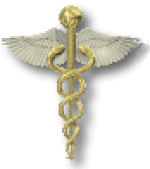 The Caduceus of Hermes and the Staff of Asclepius
The Caduceus of Hermes and the Staff of Asclepius
These are two entirely different things which look similar. The caduceus, a traditional symbol of Western medicine, is in fact the staff of Hermes and has nothing to do with the 1200 BC Greek physician Asclepius, who was later deified, as the Greeks were wont to do with their impressive people.
The caduceus story in brief: Tiresias, the blind seer and soothsayer, was said to have tried to separate two copulating snakes with his staff, which act transformed him into a woman until he was able to undo his act by repeating it, making him the first serial transgenderista. (Fair warning to snake-handlers.) Somehow, this staff, with the two snakes in love, was passed on to the god Hermes (Roman Mercury), the messenger god and the escort of the dead. (Hermes was a derivation from the Egyptian bird-headed god Thoth, to whom is attributed the authorship of The Book of the Dead.) The word caduceus is a derivation of the Greek karykeion, or "herald's staff." The association of the caduceus with medicine was an odd one, as in the 1600s Hermes was taken on as the symbol of alchemy (hence "hermetic", referring to magic and the occult) and hence to medicine.
The more appropriate symbol of medicine, and increasingly in use, is the staff of Asclepius, the god of healing - one snake only and no wings of Hermes. The Asclepia were the Greek medical schools (Asclepion - singular) and healing centers. Was the original sign that Greek physicians hung at their doorways a worm on a stick, signifying their ability to de-worm people? It's not clear. But the asclepia were known for keeping non-venomous snakes around, for some reason. Pets? More detail on the subject here - a piece which I was surprised to find addressed exactly what I had intended to.


 The Caduceus of Hermes and the Staff of Asclepius
The Caduceus of Hermes and the Staff of Asclepius
Flowers, Gospel, and the Ruby-Throated HummingbirdA few fun facts about pre-1900 education in the USThe Caduceus of Hermes and the Staff of AsclepiusBlob of the Week: Slime Mold
Tracked: Jul 15, 07:22